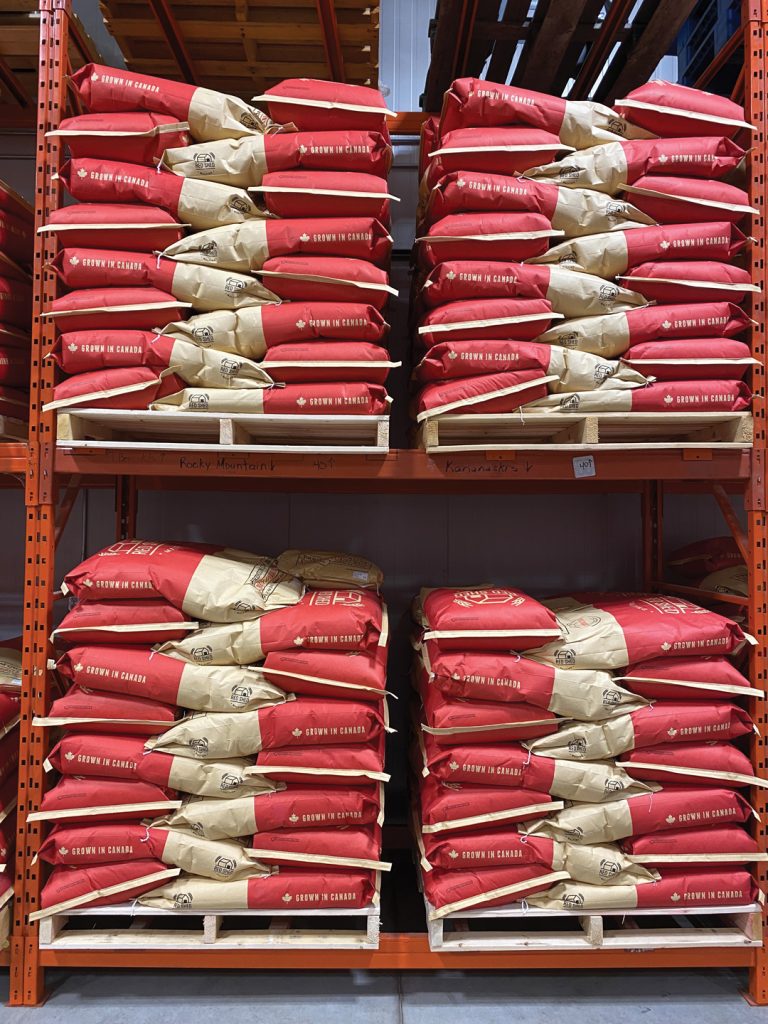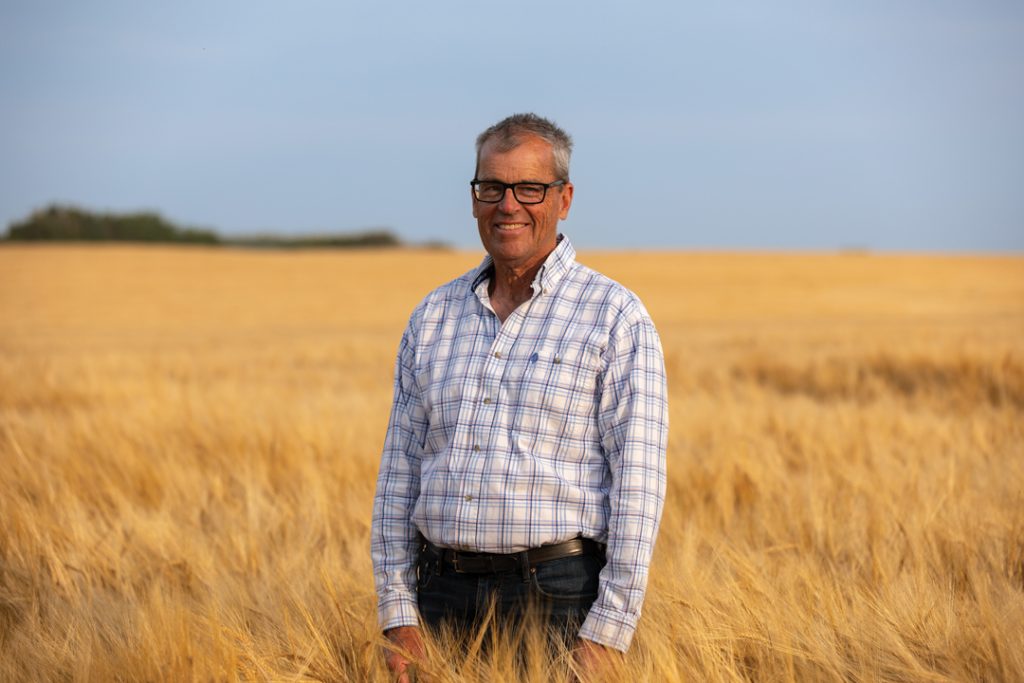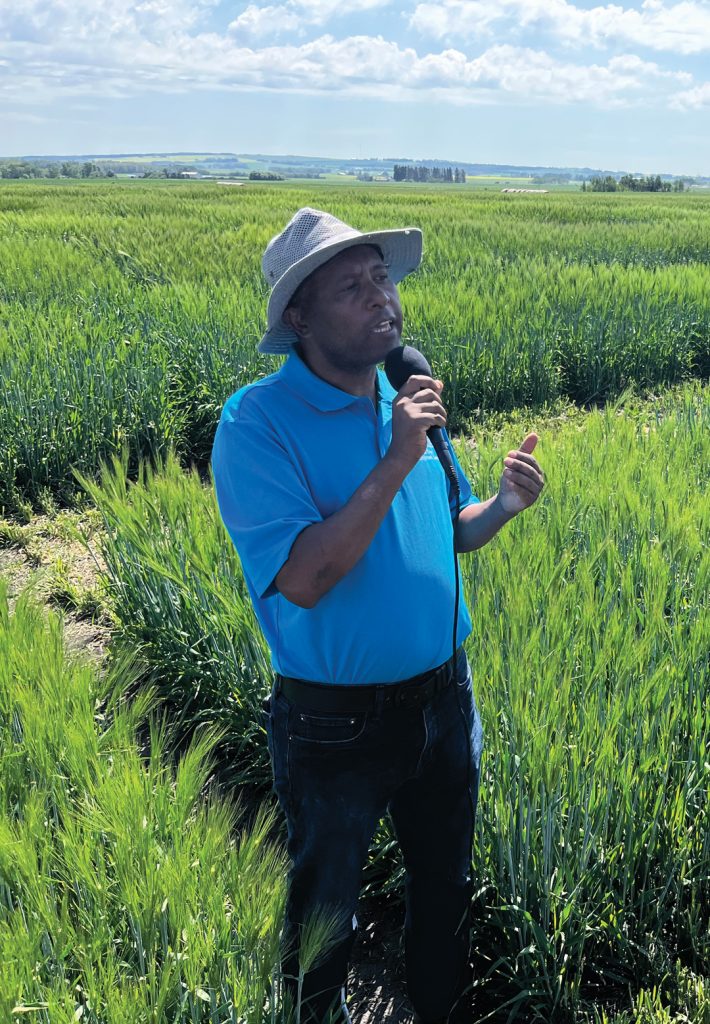HITS, MISSES AND LESSONS LEARNED
STORY AND PHOTOS BY MELANIE EPP
On a sunny day late last June, a group of agricultural journalists from around the world gathered next to the lush barley field plots maintained by the Field Crop Development Centre (FCDC) in Lacombe. As they scrawled notes about Alberta malting barley production, the group listened to FCDC researchers discuss the varieties the facility has developed over the years, including Lowe. The group sampled Lowe Down, a one-off blonde ale by Olds College Brewery. Its ingredients included Lowe malt produced by Red Shed Malting near Innisfail.
Lowe’s strengths are its strong disease package, low DON accumulation and low lodging score. In field trials, it yielded higher than farmer favourites AC Metcalfe (12 per cent) and CDC Copeland (six per cent). Maltsters were especially drawn to the new variety’s low protein and high extracts, the perfect combination for craft brewers. To the journalists, the variety sounded promising, and it certainly made delicious beer.
Surprisingly, they learned Lowe was already on its way out of production just four years after it hit the marketplace. This illustrates the complex needs a new malting barley variety must satisfy from grain to glass along the industry value chain. There is no guarantee any new variety, no matter how promising, will be a smash hit, but knowing what does not work is in itself valuable. Certain failed varieties, Lowe notable among them, have been catalysts for change that have led to tighter industry collaboration.
THE SYSTEM
From initial cross to first sip, the industry adoption process for malting barley is long and expensive. Industry experts estimate it costs approximately $1.5 million to take a single variety to the registration stage. The breeding timeline has shrunk in recent years, but it has typically been a 10- to 12-year process. With seed multiplication and malting and brewing evaluations, it can take 15 or more years to get a new variety into production.
Once developed, registration of new varieties requires the support of three committees prior to registration by the Canadian Food Inspection Agency (CFIA). These teams fall under the Prairie Recommending Committee for Oat and Barley.

The Barley Quality Evaluation Team, a subcommittee composed of maltsters, brewers and additional value chain representatives assesses the grain for chitting or pre-germination, as well as plump and friability. Quality factors such as beta-glucan, viscosity, protein, enzyme and extract levels are also assessed. The small volume of seed produced by breeders in field plots does limit the effectiveness of this data gathering. For example, one kilogram quantities are used to create malt samples.
“Micro-malting gives us an indication of malt quality, however, larger quantities of seed are required for plant-scale testing and that takes time,” said Gina Feist, executive director of the Brewing and Malting Barley Research Institute (BMBRI).
Prior to registration, new lines are also field tested at multiple geographic locations by the Disease Evaluation Team and the Agronomy Evaluation Team. Trial results include yield and agronomic data on maturity, lodging resistance and disease tolerance.
Once registered, a new line is made available for licensing and commercialization by seed companies that invest heavily to accelerate seed production. Once an adequate amount of seed is produced, the companies work with maltsters to test new lines at plant scale. Maltsters such as Canada Malting and Rahr Malting Canada need significant tonnage to begin such testing, which takes several years to complete.
LOWE AND MEREDITH
Lowe first appeared in the annual 2018–19 Canadian Malting Barley Technical Centre (CMBTC) Recommended Malting Barley Varieties report as a new variety in development. CMBTC noted the variety exhibited suitable quality characteristics for all-malt and adjunct brewing styles. Approved for registration by the CFIA, it was in the process of seed propagation by SeCan, a not-for-profit seed distributor.
Though it made the list two additional years running, its failure to do so in 2021–22 signalled trouble. CMBTC noted contracting opportunities did exist for the variety, but in 2022-23 the report didn’t even mention Lowe. While the variety showed promise on paper, troubling characteristics appeared in the field.
Farmers want a malting barley variety that has good standability, does not mature too late, has low protein and high yield. “Lowe had straw strength issues coming out of the gate, and it wasn’t a top yielder,” said Jim Downey, research and development manager at SeCan. This was a surprise given its good numbers in field trials.
Kevin Sich is supply chain director for Rahr Malting. When Lowe was released, he had high hopes for the variety. “Lowe was bred for the craft brewer, and Rahr Malting is a big player in the craft brewing industry,” he said. Results from two years of field trials, though, were not favourable. “Farmers who experimentally grew a quarter-section of it said they weren’t liking it. That was a red flag. If you can’t get your growers to grow it and farmers aren’t happy with it, you’ve got a problem.” In the malthouse, results also didn’t look good. Sich made the difficult decision to pull the plug. “We realized this variety wasn’t going to do what we hoped. It didn’t fit our customer profile.”

Farmer John Hamill had similar experiences with Lowe. He chose to grow the variety because his son, Matt, owner of Red Shed Malting, thought it would be a good fit for his microbrewery customers. John thinks he may have been the last farmer to grow Lowe, and he’s 90 per cent sure he won’t sow the variety in 2024.
There were challenges in the field, including lodging and harvest issues. A taller plant, Lowe would wrap around the feeder and jam it. “We were willing to put up with those agronomic problems if the craft brewer wanted it,” he said. “But we’re just not getting the interest from the brewers. They’re not as concerned about varieties as we thought they might be.”
Lowe isn’t the only variety to have shown great promise only to disappear. CDC Meredith, a two-row malting barley variety, created similar buzz when it was supported for registration in 2008. A moderate-enzyme, low-protein variety, it outyielded older varieties by as much as 20 per cent. SeCan licensed Meredith soon after the CFIA approved its registration.
“Meredith was going to revolutionize the barley industry,” said Sich with a chuckle. “When it came out it just blew the socks off, agronomically.” Results weren’t bad in the malthouse either, and farmers expressed interest in growing the variety. “Meredith was making life exciting in the malting industry again because farmers wanted to grow it.”
The first sign of trouble appeared when Rahr technicians reported inconsistencies in the malting process. “They’d have it dialled in for a week, and then it would change on them, and they didn’t like that,” said Sich. “We kept adjusting and making it work.”
In 2012, red flags popped up everywhere. Brewers reported high beta-glucan levels, which created high-viscosity, sticky worts that were difficult to run off. They also reported off-flavoured wort described as grassy, green, earthy and dirty. Sometimes quality issues are batch specific, but when they surface repeatedly, the brewer will call their maltster. “As soon as they have that conversation, the maltster just shuts it down and says, ‘I’m not buying that variety anymore,’” said Downey. “And that feeds back very quickly to grain buyers.”
By the time news reached Downey, the variety had been promoted by CMBTC as an up-and-comer, but marketing ramped up before it had been fully evaluated. “Arguably, you could say that industry learned a lot from Meredith,” said Peter Watts, managing director of the CMBTC. “The issue wasn’t that it made it all the way to the brewers. The issue was that it was promoted heavily before it was accepted by the brewers.
“A lot of farmers felt burned,” he added. “Several hundred thousand tonnes of Meredith was produced in 2013, and they had no malting market for it.”
LESSONS LEARNED
Lowe and Meredith may not have endured, but the industry-wide change they sparked will hopefully be long lasting. Industry players learned to confirm widespread market acceptance before sending the signal to scale up, said Watts. While waiting for those signals has kept industry from repeating the Meredith situation, it has unfortunately slowed the process of moving new varieties forward, he added.
Watts thinks Lowe may have stood a chance had it been better marketed. However, he added it is always best to pull the plug if issues repeatedly surface. Downey agreed and added large-scale maltsters do not want to handle more than two or three varieties at a time. Breeders should have killed Lowe as soon as they saw it had standability issues in field trials, he said. “We take risks to try things, but slowly we’re learning over the years that if there’s any clue that it’s going to be tough to grow or tough to market, we know it’s not going to fly.”
At Rahr Malting, Sich learned a lesson from Meredith as well. While he plans to continue to push new varieties, batch testing will need to show consistent results for three to four years before he’ll push test varieties out to brewers. “We’re maybe more baby steps now,” he said.
COMMUNICATION AND CO-OPERATION
In a supply chain as long and complex as that of malting barley, transparency and communication between industry players are key to long-term success. Four years ago, BMBRI and CMBTC partnered to form a variety acceptance committee to bolster communication and increase transparency. Under the leadership of Feist and Watts, the committee allows maltsters and brewers to confidentially discuss new varieties in the earliest stages of development. The committee’s aim is to send signals to seed companies about prospective demand so supply will be there when industry is ready to begin commercial-scale evaluation.
“There has been good collaboration around the table internally,” said Watts. “We’re working really hard as a team to promote new varieties to [maltsters and brewers] everywhere, whether it’s domestic or international.”

In Alberta, FCDC also works hard to strengthen its breeding program and increase uptake of new varieties under the leadership of program director Kofi Agblor. Agblor joined FCDC in July 2022 when the program was in a state of uncertainty. It had operated under the provincial government since 1973 but was offloaded to Olds College in January 2021. While FCDC remains housed in its Lacombe facility with its pathology, biotechnology and quality laboratories, it now operates under a three-year, temporary contract. Agblor and his colleagues have drawn up an improved business plan to secure long-term funding for the program.
The move to Olds College has been a good one. The program’s main source of funding, aside from farmer dollars, had been the government. It is now open to new funding sources necessary to support a thriving and competitive breeding program. “The post-secondary environment at Olds College is the right place for that,” said Agblor.
FCDC barley breeder Yadeta Kabeta and research cereal geneticist Jennifer Zantinge are enthusiastic about the program’s new direction. With Olds College, the Centre has increased its number of field test sites from four to nine. These are located across Alberta from Lethbridge to Fort Vermilion, which allows for wider field testing under varying soil and climatic conditions. New varieties are also tested in Saskatchewan, Manitoba and Quebec in collaboration with additional breeding programs.
Before starting work on new varieties, the two researchers look to CMBTC and seed companies for market signals. CMBTC provides clarity on brewer and maltster demands, both domestically and internationally, while seed companies alert them to developing agronomic issues.
Under the revamped program, Zantinge uses genomic technologies to speed up breeding and improve genetic selection. Doing so allows her to concentrate traits of importance. Together, she and Kabeta are attempting to determine which genetic markers are associated with low DON levels in Lowe and trying to bring better scald resistance into new feed and forage lines. Scald resistance markers are already used within the current malt breeding program.
Kabeta is also convinced there is a lesson to be learned from Lowe. “In our breeding program, we want to do things differently. We’re hoping to work from field all the way to brewing. We have a competitive advantage being at Olds College, for sure.”
COLLABORATION IS KEY
In addition to the creation of new funding opportunities, FCDC’s move to Olds College offers opportunities to test new varieties in the lab, in the field and in its on-site brewery. Its location offers advantages, too. Craft maltster Red Shed and craft breweries Troubled Monk of Red Deer and Blindman Brewing of Lacombe are within 50 kilometres of the College.
The Olds College Smart Farm has access to 3,600 acres of crop and forage land where varieties can be tested to ensure they meet agronomic demands. The teaching brewery has been used to compare taste attributes through the brewing of single-malt beers such as Lowe Down and Brew Up, made with AB BrewNet, another FCDC variety.
Lori Oatway, FCDC’s cereal quality research scientist, acquired micro-malting equipment from Europe that will be installed in the teaching brewery and used to test small batches of promising new varieties. Samples previously had to be sent to outside facilities for testing. “The micro-malting equipment will allow us to analyze thousands of samples each year on a small malt basis, so we can find out what the extract is, what the enzyme levels are,” she said.
Oatway also works with a sensory panel to detect and quantify beer attributes. Composed of trained experts, the panel evaluates beer for texture, flavour and aroma. While Oatway hasn’t had the opportunity to evaluate beers brewed with new FCDC varieties just yet, in the near future she plans to work with the sensory panel to do so.
One participating panelist is Shane Groendahl, co-founder of Blindman Brewing in Lacombe. He and Oatway are considering brewing new varieties in small batches to assess their performance before these are registered and made available to seed companies. Groendahl is proud to be part of the process. “I try to talk about the importance of barley breeding for malt featuring FCDC every chance I get. No barley, no beer.”
Oatway also sees opportunities to expand FCDC’s collaboration with Red Shed. Co-owner Matt Hamill is passionate about promoting new malting barley varieties and the modest size of the operation gives it flexibility. While the big maltsters may process 450 tonnes at once, Red Shed can handle as little as two tonnes of barley per batch. “We’ve been lucky to get first crack at some of these new varieties because we have such a small system,” said Hamill. “I love the role that we’re playing.”
Also passionate about promoting new malting barley varieties, Charlie Bredo is co-founder of Troubled Monk, which produces craft beers and whiskies. He believes the province offers unique flavours that are influenced by terroir—the environmental conditions, including soil and climate that confer “taste of place.” To promote Alberta grain, industry has to work together, he said.
“I think it’s integral to Alberta’s long-term success—from being a barley producer and developing our beer and whisky industries—that there’s integration throughout the entire chain. We need to work together to make this happen.”







Comments